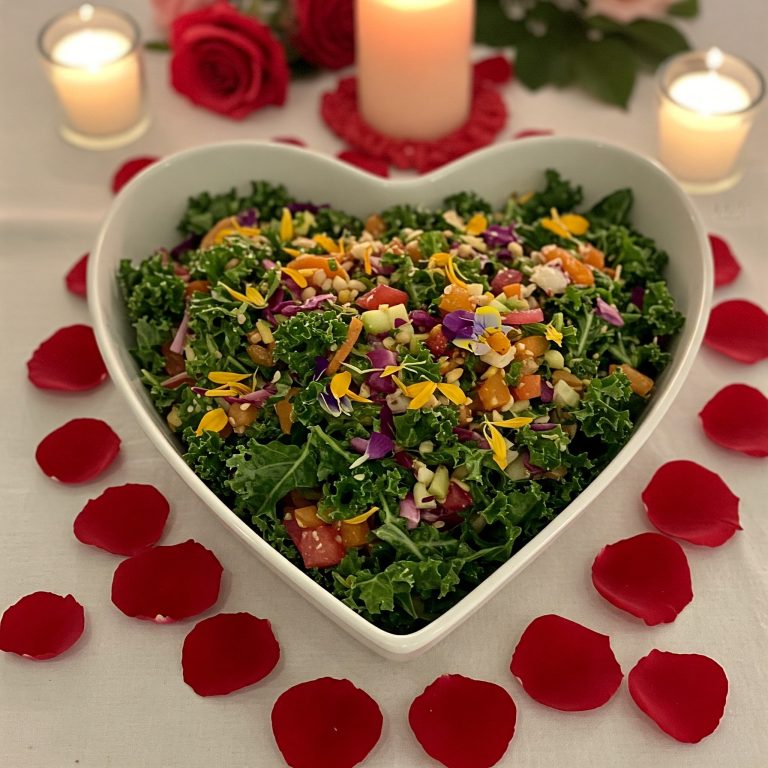Looking for a Valentine’s Day dish that’s both romantic and healthy? Skip the heavy, calorie-laden meals and opt for something vibrant and delicious: a Cornucopia kale salad. This recipe is perfect for a cozy dinner for two, combining the goodness of kale with a variety of flavorful ingredients.
This article will provide you with a simple yet elegant Cornucopia kale salad recipe, outlining all the necessary Cornucopia kale salad ingredients and a delightful Cornucopia kale salad dressing. Get ready to impress your loved one with a dish that’s as good for the body as it is for the soul – keep reading to discover how to create this memorable Valentine’s Day salad!
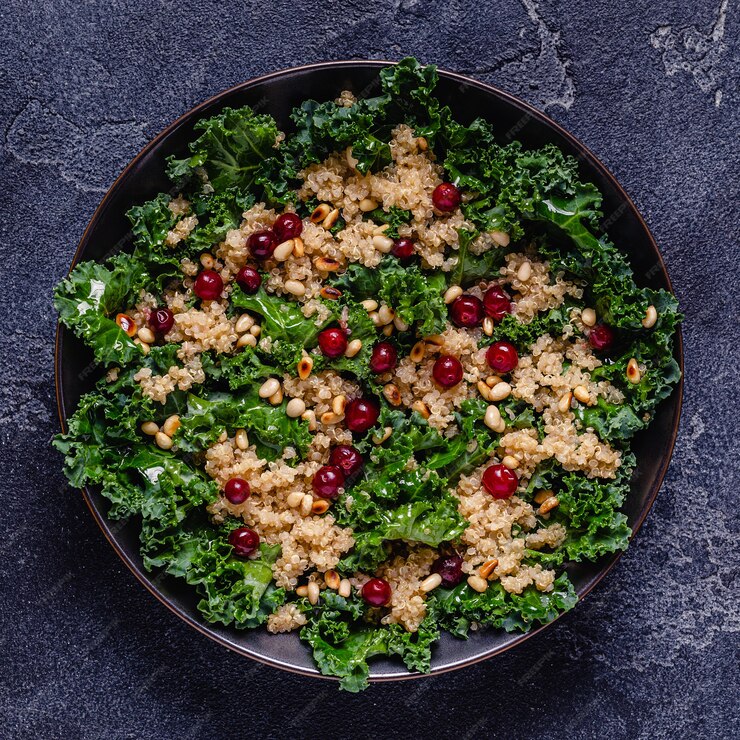
Cornucopia Kale Salad Ingredients:
- 1 bunch of kale, stems removed and leaves chopped
- 1/2 cup pomegranate seeds
- 1/2 cup dried cranberries
- 1/4 cup toasted pecans or walnuts
- 1/4 cup crumbled vegan feta cheese (optional)
- 1/4 red onion, thinly sliced
- 1/4 cup cooked quinoa (optional, for added protein)
Cornucopia Kale Salad Dressing Ingredients:
- 3 tablespoons olive oil
- 2 tablespoons balsamic vinegar
- 1 tablespoon maple syrup
- 1 teaspoon Dijon mustard
- 1/2 teaspoon dried thyme
- Salt and pepper to taste
Prep Time: Approximately 20 minutes (including washing, chopping, and dressing preparation)
Cook Time: Approximately 5 minutes (for toasting nuts and cooking quinoa, if using – these can be prepped in advance)
Total Time: Approximately 25 minutes
Serving Size: 2 servings
Estimated Cost (US Market): $19 – $32 (USD)
Note: This is a very rough estimate. Prices can fluctuate significantly. Buying ingredients in bulk or when on sale can help reduce the overall cost. Also, omitting the vegan feta or quinoa will lower the cost. If you already have some of the pantry staples, the cost will be even lower.
Step 1: Prepare the Kale
Wash and thoroughly dry the kale leaves. Remove the tough stems and chop the leaves into bite-sized pieces. Massaging the kale for a few minutes with a little olive oil can help soften it and make it more palatable.
Step 2: Combine Salad Ingredients
In a large bowl, combine the chopped kale, pomegranate seeds, dried cranberries, toasted pecans or walnuts, red onion, and crumbled vegan feta (if using). Add the cooked quinoa if you desire a more substantial salad.
Step 3: Make the Dressing
In a small bowl or jar, whisk together the olive oil, balsamic vinegar, maple syrup, Dijon mustard, and dried thyme. Season with salt and pepper to taste. You can also shake the ingredients together in a jar with a tight-fitting lid.
Step 4: Dress the Salad
Pour the dressing over the kale salad and toss gently to coat all the ingredients. Be sure to dress the salad just before serving to prevent the kale from wilting.
Step 5: Serve and Enjoy
Serve the Cornucopia kale salad immediately. This vibrant and flavorful salad makes a perfect appetizer or light meal for your Valentine’s Day celebration. Enjoy this healthy and romantic dish with your loved one!
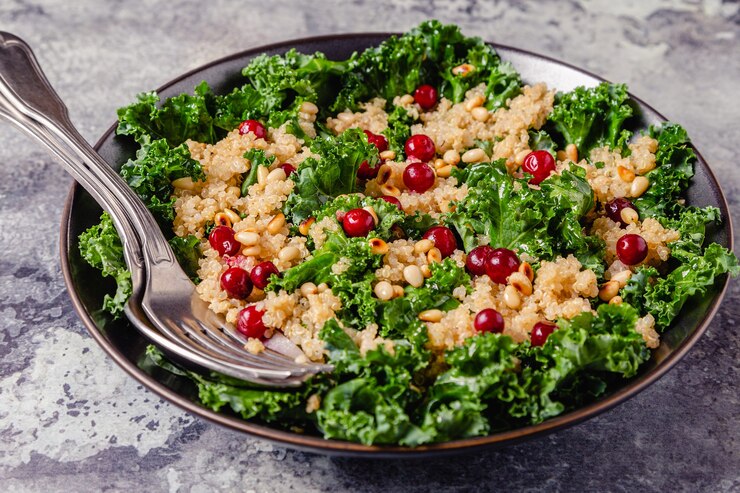
Storage and Reheating Instructions for Cornucopia Kale Salad
Dressed Salad: It’s best to dress the kale salad just before serving. If you have leftover dressed salad, it will keep in an airtight container in the refrigerator, but the kale will likely wilt and the other ingredients may soften. It’s best consumed within 24 hours, but the texture won’t be as good as freshly dressed salad.
Undressed Salad: If you anticipate having leftovers, store the undressed salad (kale, toppings) separately from the dressing. Store the undressed salad in an airtight container in the refrigerator. It will keep for 2-3 days. Store the dressing in a separate airtight container at room temperature or in the refrigerator (depending on the ingredients in your dressing).
- Dressed Salad: Best consumed within 24 hours, though it might be safe for up to 2 days (quality will decline).
- Undressed Salad: The undressed salad components will last for 2-3 days in the refrigerator. The dressing will last for several days to a week, depending on how it’s stored.
Reheating (Not Recommended for Best Taste): Kale salad is generally best served cold. Reheating is not recommended as it will further wilt the kale and likely change the texture of the other ingredients. The fresh, crisp quality of the salad will be lost.
Best Way to Enjoy Leftovers:
Dressed Salad: If you have leftover dressed salad, it’s best to enjoy it cold as is, even if the texture isn’t ideal. You could add some fresh ingredients to try to revive it, but it won’t be the same as fresh.
Undressed Salad: If you have leftover undressed salad, you can toss it with the dressing just before serving. This will give you the closest experience to a fresh salad. You can also get creative and add other fresh ingredients to make it a new meal. For example, you could add some grilled chicken or fish for a heartier meal (if not strictly vegan anymore).
Tips for Keeping Kale Salad Fresh:
- Massage the Kale: Massaging the kale with a little olive oil or lemon juice helps soften it and makes it more palatable, even after a day or two in the fridge (undressed).
- Store Ingredients Separately: As mentioned above, storing the dressing and salad components separately is the best way to maintain freshness.
- Don’t Overdress: Only dress the amount of salad you plan to eat immediately.
By following these storage and “reheating” suggestions, you can enjoy your Cornucopia Kale Salad at its best, even if you have leftovers. Remember, fresh is always best with salads!
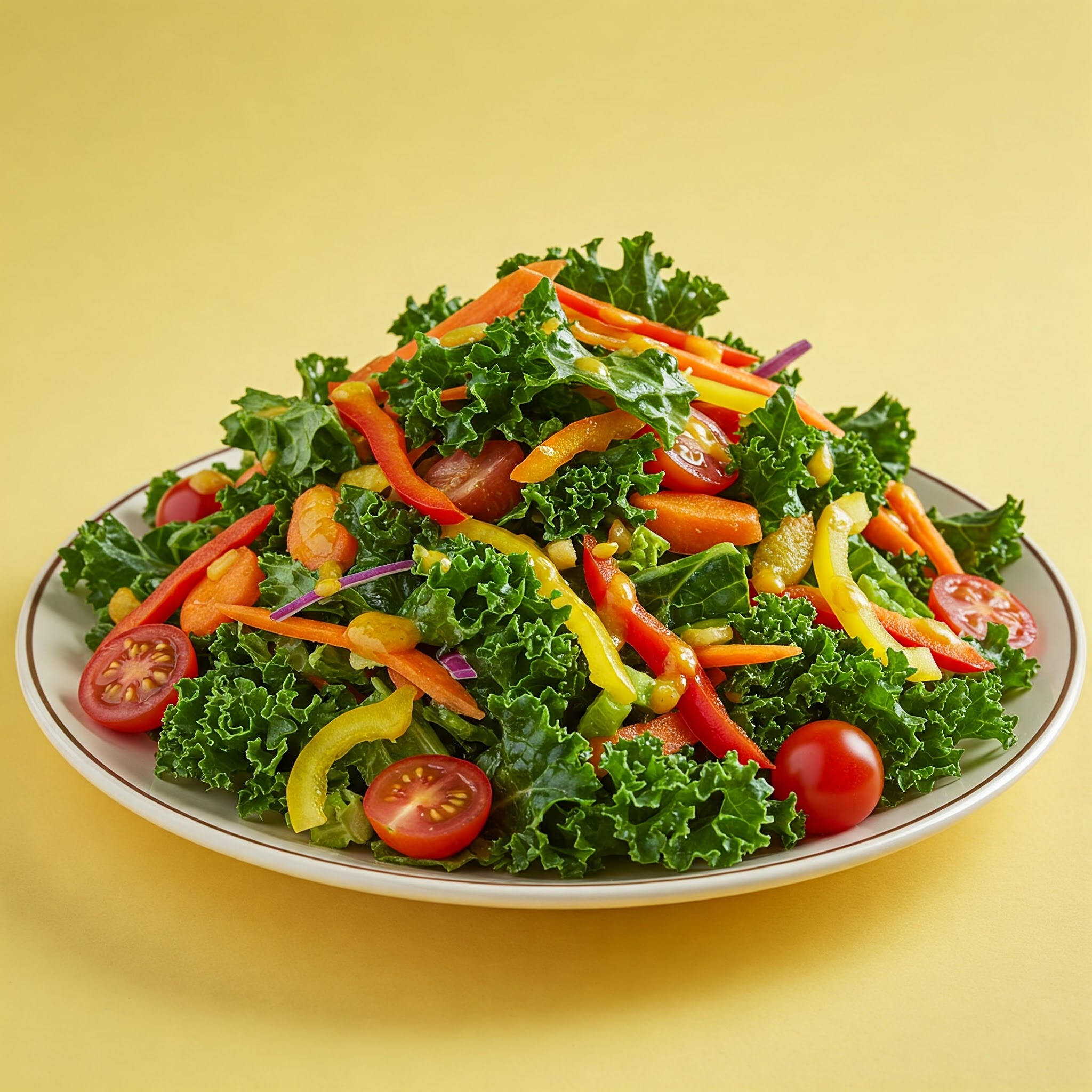
Nutrition Facts (Approximate Values per Serving – 2 Servings)
It’s important to note that these values are estimates and can vary based on specific ingredient brands, portion sizes, and preparation methods. This information is for guidance only and should not be substituted for professional dietary advice.
| Nutrient | Amount per Serving | % Daily Value* |
| Calories | ~250-350 | ~13-18% |
| Total Fat | ~15-25g | ~23-38% |
| Saturated Fat | ~2-4g | ~10-20% |
| Unsaturated Fat | ~13-21g | N/A |
| Cholesterol | 0mg | 0% |
| Sodium | ~50-150mg | ~2-6% |
| Total Carbohydrate | ~20-30g | ~7-10% |
| Dietary Fiber | ~5-8g | ~20-32% |
| Total Sugars | ~10-15g | N/A |
| Includes Added Sugars | ~5-8g | ~10-16% |
| Protein | ~5-8g | ~10-16% |
| Vitamin A | High | High |
| Vitamin C | High | High |
| Vitamin K | High | High |
| Potassium | Moderate | Moderate |
| Iron | Moderate | Moderate |
*Percent Daily Values are based on a 2,000 calorie diet.
Important Considerations:
- Vegan Feta: The nutritional content will vary depending on the brand and type of vegan feta cheese used. Some vegan cheeses can be higher in saturated fat.
- Quinoa: Adding quinoa will increase the protein, fiber, and carbohydrate content of the salad.
- Dressing: The dressing contributes to the fat and calorie content. Using less oil will reduce these values.
- Serving Size: The values above are estimates for a single serving. Adjustments should be made based on individual portion sizes.
This table provides a general overview. For more precise nutritional information, it is recommended to use a nutrition calculator and input the specific brands and quantities of ingredients used in your recipe.
Dietary Information
This Cornucopia Kale Salad recipe, as presented, is:
- Vegan: It uses no animal products.
- Vegetarian: Naturally vegetarian.
- Gluten-Free: All the listed ingredients are naturally gluten-free. However, it’s always wise to double-check the labels of any packaged ingredients (like the vegan feta or maple syrup) to ensure they are certified gluten-free, especially if you have a severe gluten intolerance or celiac disease. Some processing facilities may handle gluten-containing products.
- Dairy-Free: As it’s vegan, it is also dairy-free.
- Soy-Free (Potentially): Whether it’s soy-free depends on the specific brand of vegan feta you choose. Many vegan cheeses are soy-based, so read the label carefully if you need a soy-free option. The rest of the recipe is inherently soy-free.
Important Note about Keto: This recipe, in its current form, is not suitable for a strict ketogenic diet due to the higher carbohydrate content from the fruits (pomegranate seeds, cranberries) and maple syrup in the dressing. While kale itself is low-carb, the other additions push the carb count higher.
Modifications for Keto:
If you wish to make this keto-friendly, you would need to make significant modifications:
- Reduce or Eliminate Fruit: Drastically reduce or completely remove the pomegranate seeds and dried cranberries.
- Sugar-Free Sweetener: Replace the maple syrup in the dressing with a keto-approved sweetener (like erythritol or stevia).
- Increase Fat: Increase the amount of olive oil in the dressing to add more healthy fats.
- Consider Adding Protein: If you remove the fruit, consider adding a keto-friendly protein source like grilled chicken or fish (if not strictly vegan).
Always Check Labels: It’s crucial to check the ingredient labels of all packaged products you use to ensure they meet your specific dietary requirements, especially if you have allergies or intolerances. Ingredient formulations can change, so it’s always best to be vigilant.
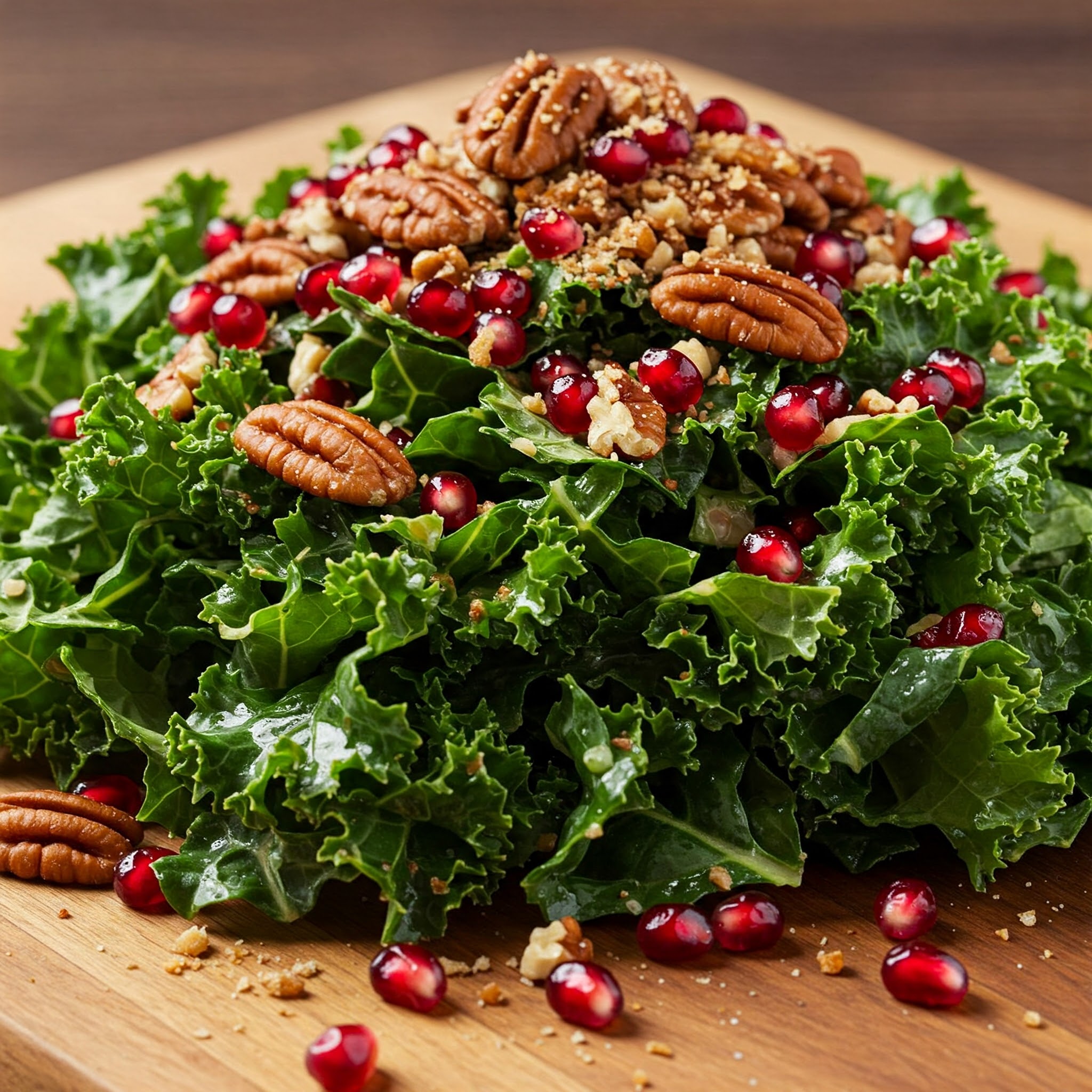
History of Cornucopia Kale Salad
The Cornucopia Kale Salad isn’t a recipe with a long, documented history like some classic dishes. It’s more of a modern creation, likely evolving from the increasing popularity of kale as a healthy ingredient in recent years. The “cornucopia” element comes from the abundance of colorful and textured ingredients, reminiscent of the horn of plenty, a symbol of prosperity and abundance often associated with harvest festivals.
Combining kale with dried fruits, nuts, and a flavorful dressing is a common approach to making kale salads more appealing. The addition of pomegranate seeds, cranberries, and pecans or walnuts gives this particular salad a festive and slightly sweet-tart profile, making it suitable for special occasions like Valentine’s Day.
While the exact origin is unclear, it’s likely a result of culinary creativity and a desire for healthy yet delicious dishes, blending contemporary food trends with classic flavor combinations.
Where did kale salad originate?
While kale itself has a long history dating back to ancient times, the kale salad as we know it is a relatively recent invention. Kale was cultivated in Europe for thousands of years, but it was often cooked or used in soups and stews. It wasn’t until the late 20th and early 21st centuries that raw kale salads started gaining popularity. This rise in kale’s popularity is linked to a growing awareness of its nutritional benefits and a desire for healthier eating options.
Chefs and food writers began experimenting with kale, finding ways to make it more palatable in its raw form, often by massaging it to soften the leaves and combining it with flavorful dressings and complementary ingredients. So, while kale has ancient roots, the kale salad is a modern dish, born out of culinary innovation and a focus on healthy eating.
What is kale salad made of?
Kale salad, at its core, is made primarily of kale, a leafy green vegetable known for its nutritional density. Beyond the kale base, a variety of ingredients are often added to enhance flavor and texture. These additions can include fruits like berries, pomegranate seeds, or dried cranberries; nuts and seeds such as walnuts, pecans, or pumpkin seeds; vegetables like red onion or shredded carrots; and sometimes cheese (though vegan options are available for plant-based salads).
A crucial component of any kale salad is the dressing, which can range from simple vinaigrettes to more complex concoctions, often using ingredients like olive oil, lemon juice, vinegar, and various herbs and spices. The combination of these elements creates a balanced and flavorful salad that can be both healthy and delicious.
Is kale salad healthy?
Yes, kale salad can be a very healthy dish. Kale itself is a nutritional powerhouse, packed with vitamins A, C, and K, as well as fiber, antioxidants, and minerals like calcium and potassium. These nutrients contribute to various health benefits, including supporting immune function, bone health, and reducing the risk of chronic diseases.
However, the overall healthfulness of a kale salad depends on the other ingredients and the dressing used. Adding too much high-fat cheese, sugary dressings, or processed toppings can diminish the nutritional benefits. A kale salad with a variety of colorful vegetables, fruits, nuts, and a light, healthy dressing (like a vinaigrette made with olive oil) is an excellent way to incorporate more nutrients into your diet.
What does kale salad taste like?
Kale salad’s taste can vary depending on the specific ingredients and dressing, but the kale itself has a slightly earthy, sometimes slightly bitter, and robust flavor. Raw kale can be a bit tough, but massaging it with dressing helps soften the leaves and mellow the bitterness. The taste of a kale salad is often a balance between the kale’s inherent flavor and the other added components.
Sweet additions like fruits or a touch of maple syrup in the dressing can complement the kale’s earthiness, while nuts and seeds add a crunchy texture and nutty flavor. The dressing plays a crucial role, tying all the flavors together and adding brightness, acidity, or sweetness. Overall, a well-made kale salad offers a complex and satisfying mix of textures and flavors, ranging from savory and earthy to sweet, tangy, and nutty.
Final Thoughts
This Cornucopia Kale Salad offers a delightful and healthy alternative to heavier Valentine’s Day meals. It’s a vibrant and flavorful way to show your love while nourishing your bodies. The combination of hearty kale, sweet and tart fruits, crunchy nuts, and a tangy dressing creates a symphony of textures and tastes that’s perfect for a romantic dinner for two.
While this recipe is designed with Valentine’s Day in mind, it’s versatile enough to be enjoyed any time of year. Whether you’re celebrating a special occasion or simply looking for a nutritious and delicious meal, this Cornucopia Kale Salad is sure to impress. So, ditch the calorie-laden dishes and embrace the freshness and goodness of this vibrant salad. It’s a gift to your loved one and yourself – a celebration of love and healthy living.

